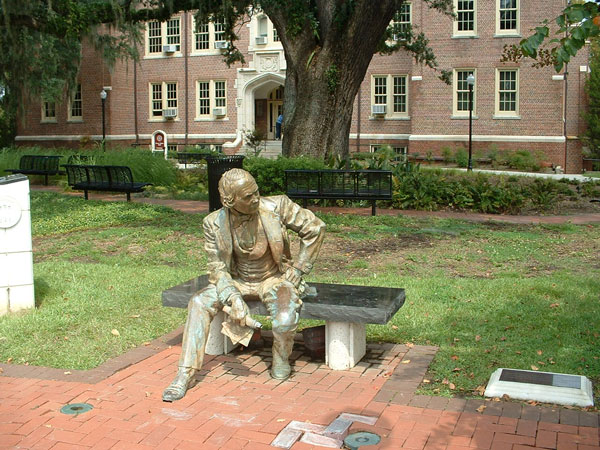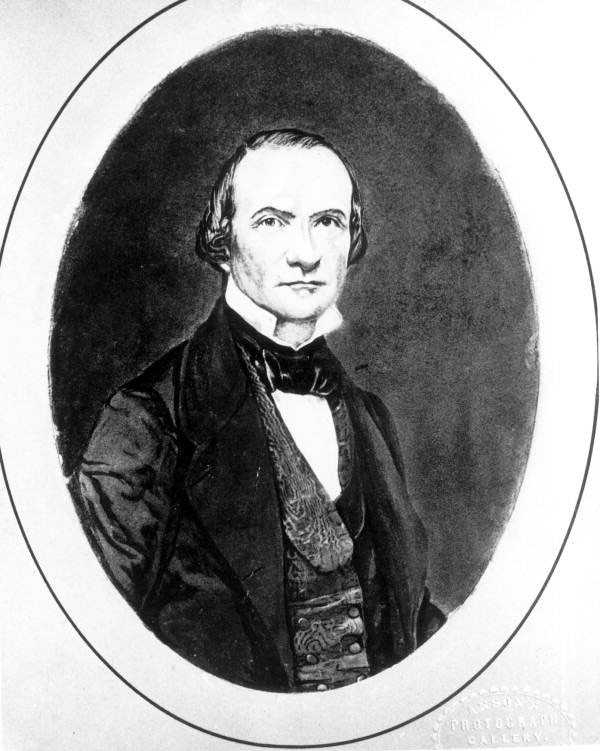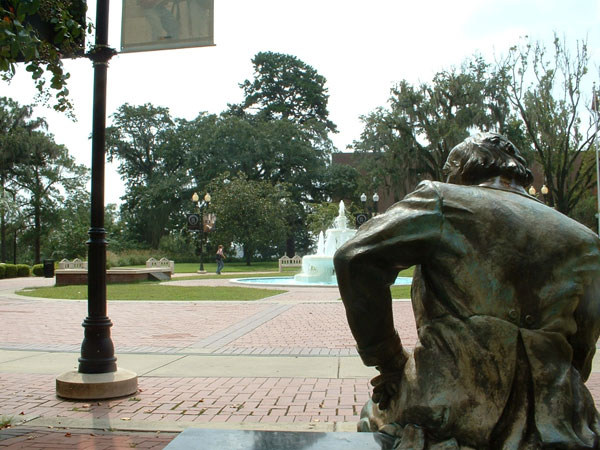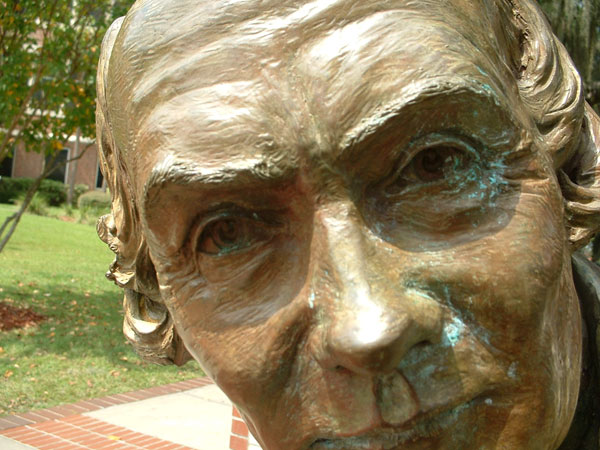 |
 |
| Home>> Monuments
and Memorials>> Francis Eppes Statue |
|
Francis Eppes Statue by Andrew Waber
In the 1999 State of the University Address, FSU President Sandy D’Alemberte wanted Florida State University to recognize its unique history and those who made it possible. In a continuation of the overall campus improvement project begun in 1989, he sought a unique form of commemoration in the erection of statues honoring major contributors to the first 150 years of Florida State University. The first of these statues was the Francis Eppes Monument in front of the Westcott Building, honoring the man declared “Founder of Florida State University.” (1) 2001 was a banner year for FSU, marking the 150th anniversary of its founding and the University ended it in style with the official unveiling of the Eppes statue on the 24th of January, 2002. The sculptor was Edward Jonas, a 1972 graduate of FSU and a prominent portraiture artist. Several other Jonas statues adorn the Florida State campus, including the “Sportsmanship” and Landis Green Legacy Fountain sculptures.
The rationale behind Eppes’ consideration as the “founder” of what became FSU often confuses the public about what role he played in its founding. The truth is the founding of the Seminary was a group effort. When legislation passed in 1851 calling for the establishment of two state-sponsored seminaries, Eppes held no official position. By the time he became mayor again in 1856, the construction of the seminary buildings were finished one year earlier. City officials of Tallahassee took it upon itself to build the Seminary in hope that in due time the state would officially recognize it as the Seminary West of the Suwannee. Eppes’ biggest contribution to the founding of the Seminary lied in his role in securing state recognition for the school. Eppes did not take the single-handed proactive approach like his grandfather Thomas Jefferson did with the founding of the University of Virginia (3). When D’Alemberte took the office of president in 1993, he wanted to reshape the FSU campus to reflect the ideals of Thomas Jefferson: “Jefferson’s ideals of a university is to give people a sense of democracy.”(4) There is also an Eppes Building, an Eppes Chair and an Eppes Trophy all named for Francis Eppes during the presidency of D’Alemberte. Given D’Alemberte’s fascination with Jefferson, Eppes’ family connections to Jefferson played a role in the decision to erect the statue. Francis Wayles Eppes was born into one of the most influential families in America. His maternal grandfather was Thomas Jefferson, the writer of the Declaration of Independence and third president of the United States. Jefferson took a personal interest in his grandson, especially in Francis’ education. Under his grandfather’s tutelage, Eppes enjoyed a first rate education. His summers spent at Monticello would result in a life long love of books. Eppes shared his grandfather’s interests in learning and religion, but not in politics. Eppes came to Florida in 1827 and in 1835, following the death of his first wife, moved to nearby Tallahassee. (5) Francis Eppes never preferred political office. Although opportunities arose, he shied away from political office. His initial contributions to Tallahassee were outside the political sphere. Eppes was instrumental in the establishment of the first Episcopal church in Tallahassee, St. John’s Episcopal Church, in 1838. He also became a leading proponent for the establishment of public schools in the area. He also led a campaign to crack down on dueling following the death of a close friend of his named John K. Campbell from a duel. Eppes felt the need to take action after the death of General Leigh Read at the hands of Willis Alston. Alston retaliated for Read killing Alston’s brother in a duel. In 1841 Eppes became intendant mayor of Tallahassee, the first of three tenures spreading out from 1841-45, 1856-57 and 1866. During his first tenure, Eppes instituted a system of night watches in the town and abolished the local horse track. Both measures had an immediate effect in eradicating the frontier mentality of the city. A yellow fever epidemic took place in 1841 and fire broke out in the business district in 1843. Eppes received praise for his handling of the crises and gained much popularity among the people of Tallahassee. He stepped down in 1845 but would become mayor again in 1856, when his most lasting contribution to the city would occur (6) Responding to the need for state-sponsored institutions of higher learning, the Florida state legislature passed the Legislative Act of 24 Jan 1851. This act called for the establishment of two colleges with one located to the east and the other located to the west of the Suwannee. Ocala received the East Florida Seminary, which would later relocate to Gainesville and become the University of Florida. Tallahassee beat out the cities of Quincy and Marianna to receive the West Florida Seminary. Eppes served as president of the Board of Education for WFS from 1860 to after the Civil War in 1868. The Civil War years turned out to be the most difficult for the fledgling school. Conscription of teachers and male students hampered the boys school and the inflation of the Confederate dollar made it impossible to pay bills. Eppes would help keep the school open throughout the war by personally appealing to the Confederate government both in Tallahassee and Richmond for help. Cadets from the school fought in the Battle of Natural Bridge and helped keep the Union forces out of Tallahassee until the end of the war. When Union forces eventually entered Tallahassee, Eppes personally surrendered the city. He served one last term as governor in 1866. In 1868, he and the entire Board of Education resigned because of the financial difficulties Reconstruction placed on the school. The school closed in 1869, by which time Eppes left for Orange County, FL where he died in 1881 (7) 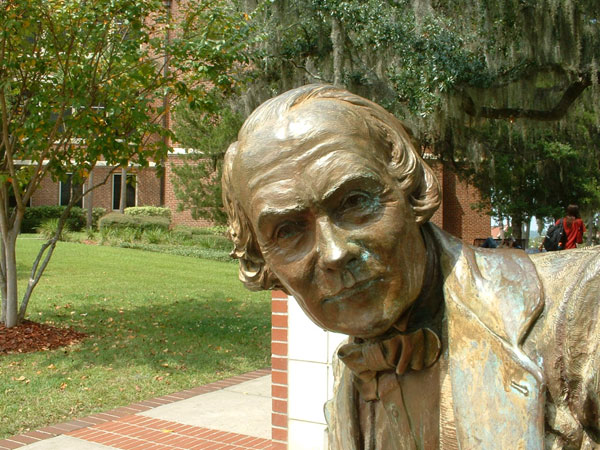 (1) D’Alemberte, Sandy, “State of the University Address- 1999: Florida State University: Embracing the Challenge of Change,” http://president.fsu.edu/99state/pages, date accessed 14 Sep 2006; Francis Eppes Monument plaque reads: “Francis Wayles Eppes 1801-1881; Grandson of President Thomas Jefferson; Founder of Florida State University.”. (2) Gerald Ensley, “FSU Celebrates Its Heritage,” Tallahassee Democrat, 25 Jan 2002; “Jonas,” http://www.edwardjonas.com, date accessed 17 Sep 2006. (3) Robin Sellers, The Jefferson Connection (unpublished paper, 1996), p. 9-12. (4) “D’Alemberte: FSU Can Have ‘Jefferson Ideals,’” Florida Flambeau, Nov 1993. (5) Susan Bradford Eppes, “Francis Eppes (1801-1881), Pioneer of Florida,” Florida Historical Quarterly, vol. 5 issue 2 (Oct 1926), p. 94-102; Malcolm B. Johnson, Red, White and Bluebloods in Frontier Florida (Tallahassee, FL: Rotary Clubs of Tallahassee, 1976); Sellers, p. 1-6. (6) Eppes, p. 99-100; David Nolan, Fifty Feet in Paradise: The Booming of Florida (San Diego, CA: Harcourt Brace Jovanovich, 1984), p. 52-53. (7)William G. Dodd, West Florida Seminary 1857-1901: Florida State College 1901-1905 (Tallahassee, FL: Florida State University Press, 1952), p. 1-52, 109-111; Sellers, p. 10-15 photographs by Andrew Waber
|
| ©
Jennifer Koslow | 453 Bellamy Building | Tallahassee FL 32306-2200 History Department | Arts & Sciences | Florida State University |















